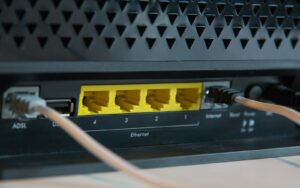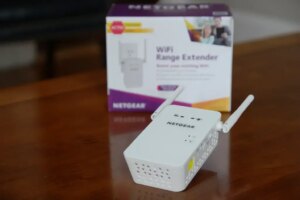A fast internet speed typically means a minimum download speed of 100 Mbps and an upload speed of 20 Mbps. This speed supports most online activities, from streaming high-definition videos to playing online games without interruption for 2-4 people.
In this comprehensive guide, we’ll explore the various aspects of internet speed, including definitions, speed requirements, factors affecting speed, and tips for optimization.
Key Takeaways
- Internet speed is measured in Mbps or Gbps and consists of download and upload speeds.
- The FCC defines broadband as a minimum of 100 Mbps download and 20 Mbps upload.
- Different online activities have varying speed requirements, ranging from 1 Mbps for web browsing to 25 Mbps for 4K video streaming.
- Factors like connection type, network congestion, router quality, and the number of connected devices can impact your internet speed.
- Optimizing your internet speed involves upgrading your plan, optimizing router placement, using Ethernet connections, managing devices, updating your router, and troubleshooting issues.
- Emerging technologies like Wi-Fi 6, 5G, and 10G networks promise faster speeds and greater capacity for the future of the Internet.
Defining Internet Speed
Internet speed refers to the rate at which data is transferred between your device and the internet. It is typically measured in megabits per second (Mbps) or gigabits per second (Gbps). The higher the number, the faster your internet connection.
There are two main components of internet speed:
- Download speed: The rate at which data is transferred from the internet to your device.
- Upload speed: The rate at which data is transferred from your device to the internet.
Another important concept related to internet speed is bandwidth. Bandwidth refers to the maximum amount of data that can be transmitted over an internet connection in a given time period. Think of it as a highway with multiple lanes. The more lanes (bandwidth) available, the more traffic (data) can flow through simultaneously.
Latency, also known as ping, is another factor that affects your overall internet experience. Latency refers to the time it takes for data to travel from your device to its destination and back. Lower latency means a more responsive connection, which is crucial for activities like online gaming and video conferencing.
Types of Internet Connections
There are several types of internet connections available, each with its own advantages and limitations. Let’s compare and contrast the most common types:
- Digital Subscriber Line (DSL): DSL uses existing telephone lines to transmit data. It offers speeds ranging from 1 Mbps to 100 Mbps, depending on the provider and plan. DSL is widely available but may experience slower speeds due to its reliance on copper wires.
- Cable: Cable internet uses the same coaxial cables as cable television to deliver internet service. It provides speeds ranging from 10 Mbps to 1 Gbps. Cable is generally faster than DSL but may experience slowdowns during peak usage hours.
- Fiber: Fiber-optic internet uses glass or plastic fibers to transmit data using light signals. It offers the fastest speeds available, ranging from 100 Mbps to 10 Gbps. Fiber is less susceptible to interference and provides consistent speeds, but its availability is limited compared to DSL and cable.
- Satellite: Satellite internet uses a dish to communicate with orbiting satellites. It is available in remote areas where other types of internet connections are not feasible. However, satellite internet typically has higher latency and lower speeds compared to other options.
- 5G: 5G is the latest generation of cellular network technology. It promises faster speeds, lower latency, and greater capacity than previous generations. 5G home internet is becoming increasingly available, offering speeds comparable to cable and fiber.
What is Considered Fast Internet?
The Federal Communications Commission (FCC) defines broadband internet as having a minimum download speed of 25 Mbps and an upload speed of 3 Mbps. However, with the increasing demand for high-quality video streaming and online gaming, the FCC has recently updated its definition of broadband to a minimum of 100 Mbps download and 20 Mbps upload.
Top internet providers offer a wide range of speed options, from 100 Mbps to 10 Gbps. For most households, a speed of 100-500 Mbps is sufficient for everyday activities like browsing, streaming, and video conferencing. Gigabit speeds (1 Gbps and above) are ideal for power users, large households with multiple devices, and those who frequently engage in data-intensive activities like 4K streaming and online gaming.
To put things in perspective, let’s compare fast internet speeds to slower ones:
- With a 10 Mbps connection, downloading a 4GB movie would take about an hour.
- With a 100 Mbps connection, the same movie would download in just over 5 minutes.
- With a 1 Gbps connection, the movie would download in less than a minute.
Internet Speed Requirements for Common Online Activities
Different online activities have varying speed requirements. Here’s a table showcasing the minimum and recommended speeds for common activities:
| Activity | Minimum Speed | Recommended Speed |
|---|---|---|
| Web browsing | 1 Mbps | 5 Mbps |
| HD video streaming | 5 Mbps | 10 Mbps |
| 4K video streaming | 15 Mbps | 25 Mbps |
| Online gaming | 3 Mbps | 10 Mbps |
| Video conferencing | 1 Mbps | 3 Mbps |
| Large file downloads | 10 Mbps | 25 Mbps |
Keep in mind that these are per-device recommendations. If you have multiple devices connected and performing these activities simultaneously, you’ll need a higher overall speed to maintain a smooth experience.
For example, if you have a household of four people, each streaming 4K video on separate devices, you would need a minimum speed of 60 Mbps (15 Mbps x 4) and a recommended speed of 100 Mbps (25 Mbps x 4).
Remote work and smart home devices also benefit from faster internet speeds. Video conferencing, file sharing, and remote access to work computers require stable and fast connections to maintain productivity. Similarly, smart home devices like security cameras, thermostats, and voice assistants rely on a consistent internet connection to function properly.
Factors Affecting Internet Speed
Several factors can impact your internet speed, even if you have a high-speed plan. Understanding these factors can help you diagnose and resolve speed issues.
- Connection Type: As discussed earlier, the type of internet connection you have (DSL, cable, fiber, etc.) plays a significant role in determining your speed potential.
- Network Congestion: During peak usage hours, such as evenings and weekends, many people are online simultaneously. This increased traffic can lead to slower speeds, especially on shared networks like cable internet.
- Router Quality: Your router is responsible for distributing the internet signal throughout your home. An outdated or low-quality router can bottleneck your speed, even if you have a high-speed plan.
- Number of Connected Devices: The more devices connected to your network, the more bandwidth is divided among them. If multiple devices are performing data-intensive tasks simultaneously, you may experience slower speeds.
- Internet Service Provider (ISP): Your ISP’s infrastructure, network management practices, and overall quality of service can impact your speed and reliability.
- Background Software and Network Usage: Applications running in the background on your devices, such as software updates or cloud backups, can consume bandwidth and slow down your connection.
Tips for Optimizing Internet Speed
If you’re experiencing slow internet speeds, there are several steps you can take to optimize your connection:
- Upgrade Your Plan: If your current internet plan doesn’t meet your needs, consider upgrading to a faster plan with your ISP.
- Optimize Router Placement: Place your router in a central location, away from walls and obstructions. Elevate it off the ground to improve signal distribution.
- Use Ethernet Connections: Whenever possible, connect devices directly to your router using Ethernet cables. Wired connections are generally faster and more stable than Wi-Fi.
- Manage Connected Devices: Disconnect devices that aren’t in use, and prioritize bandwidth for essential activities. Many routers offer Quality of Service (QoS) settings that allow you to allocate bandwidth to specific devices or applications.
- Update Your Router: If your router is more than a few years old, consider upgrading to a newer model that supports the latest Wi-Fi standards and offers better performance.
- Troubleshoot Issues: If you’re consistently experiencing slow speeds, contact your ISP for assistance. They can help diagnose and resolve issues with your connection or equipment.
When choosing an internet plan, consider your household’s current and future needs. Think about the number of devices, the types of activities you engage in, and any upcoming changes (e.g., working from home, adding smart home devices). It’s better to have a plan that slightly exceeds your needs than one that consistently leaves you frustrated with slow speeds.
The Future of Internet Speeds
As technology continues to advance, so do our expectations for internet speeds. Emerging technologies like Wi-Fi 6, 5G, and 10G networks promise to deliver faster speeds, lower latency, and greater capacity.
Wi-Fi 6, the latest generation of Wi-Fi technology, offers speeds up to 9.6 Gbps and improved performance in congested areas. It’s ideal for households with many connected devices and can help alleviate network congestion.
5G, as mentioned earlier, is the next generation of cellular network technology. In addition to powering our smartphones, 5G is also being used to deliver high-speed home internet. With speeds comparable to cable and fiber, 5G could be a game-changer for areas where traditional broadband infrastructure is lacking.
10G networks, currently in development, aim to deliver speeds of 10 Gbps and beyond. While 10G is not yet widely available, it’s a testament to the ongoing push for faster and more reliable internet connections.
As our reliance on the internet grows, so does the demand for faster speeds. From streaming ultra-high-definition video to powering advanced virtual and augmented reality experiences, the future of the internet is exciting and full of possibilities.
Conclusion
To wrap it up, knowing about fast internet speeds is key for keeping up with today’s tech needs. If your internet speed is around 100 Mbps for downloading and 20 Mbps for uploading, you’re all set. This speed helps you do everything online smoothly, like watching movies, playing games, working from home, and managing smart devices.
Choose a good internet plan that fits your needs. Also, set up your home network well. This way, your internet will work fast and keep up with new technology changes.
FAQs
What is a good internet speed for streaming?
For streaming HD video, a minimum speed of 5 Mbps is required, but 10 Mbps is recommended. For 4K video, a minimum of 15 Mbps is needed, with 25 Mbps being the recommended speed.
How can I test my internet speed?
You can test your internet speed using online tools like Speedtest.net or Fast.com. These tools measure your download and upload speeds and provide a snapshot of your connection’s performance.
Why is my internet slow even though I have a high-speed plan?
Several factors can impact your internet speed, even with a high-speed plan. Network congestion, outdated equipment, the number of connected devices, and background software can all contribute to slower speeds. Try optimizing your setup and troubleshooting issues with your ISP.
What is the difference between Mbps and Gbps?
Mbps stands for megabits per second, while Gbps stands for gigabits per second. One gigabit equals 1,000 megabits, so 1 Gbps is equivalent to 1,000 Mbps.
Do I need gigabit internet speeds?
Gigabit internet speeds (1 Gbps and above) are ideal for large households with many connected devices and those who frequently engage in data-intensive activities like 4K streaming and online gaming. However, for most households, speeds of 100-500 Mbps are sufficient for everyday needs.




